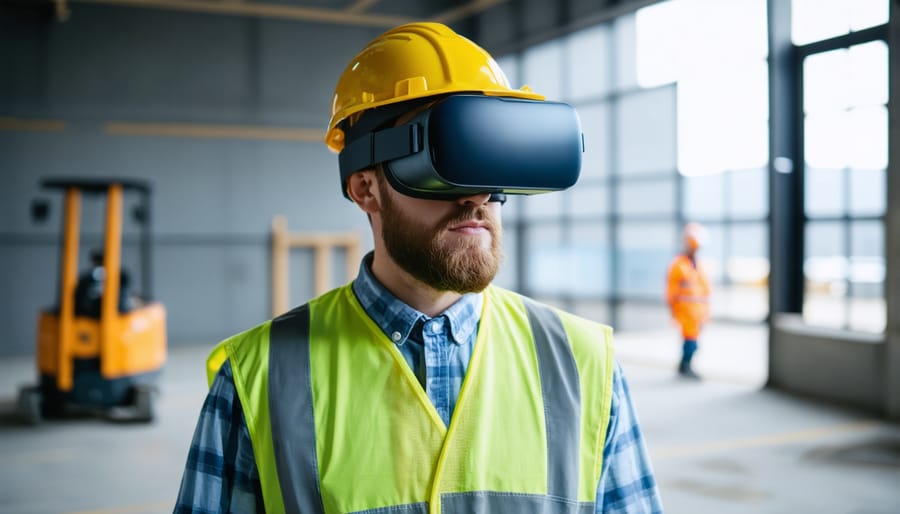Transform your workforce development strategy by addressing the widening digital construction skills gap through innovative, data-driven approaches. Industry leaders are revolutionizing talent development by implementing AI-powered training platforms, creating cross-functional mentorship programs, and establishing partnerships with technical institutions.
The construction sector’s evolution demands a fundamental shift in how we cultivate talent. Advanced simulation technologies now enable workers to master complex tasks in risk-free environments, while predictive analytics identify skills gaps before they impact productivity. Leading firms report a 40% increase in worker retention and a 25% improvement in project efficiency through these modern training methodologies.
By integrating virtual reality training modules, establishing clear career progression frameworks, and developing micro-credentialing programs, forward-thinking organizations are building agile, future-ready teams. This systematic approach to workforce development doesn’t just address immediate skills shortages—it creates a sustainable pipeline of qualified professionals ready to tackle tomorrow’s construction challenges.
Technology-Driven Skills Development
Virtual Reality Training Platforms
Virtual Reality (VR) training platforms represent a significant leap forward in technology adoption in construction training, offering immersive learning environments that revolutionize how workers develop critical skills. These platforms enable construction professionals to practice complex procedures and emergency responses in a risk-free virtual environment before executing them on actual job sites.
Recent implementations by industry leaders demonstrate VR’s effectiveness in safety training, with companies reporting up to 70% reduction in workplace incidents following VR-based safety programs. The technology allows workers to experience hazardous scenarios and practice appropriate responses without physical risk, creating muscle memory for proper safety protocols.
Beyond safety applications, VR platforms excel in technical skill development. Workers can practice equipment operation, assembly procedures, and specialized construction techniques through realistic simulations. These platforms offer real-time feedback and performance metrics, enabling trainers to identify areas requiring additional focus and adjust training programs accordingly.
Cost analysis from early adopters indicates that while initial investment in VR technology is substantial, the return on investment typically manifests within 12-18 months through reduced training costs, decreased accident rates, and improved worker proficiency. The ability to simulate multiple scenarios and repeat training exercises indefinitely makes VR particularly valuable for organizations with large workforce development needs.
As hardware costs continue to decrease and software capabilities expand, VR training platforms are becoming increasingly accessible to construction companies of all sizes, marking a transformative shift in workforce development methodology.

Mobile Learning Solutions
Mobile learning solutions have revolutionized workforce development in the construction industry, offering unprecedented flexibility and accessibility for training and skill development. Through dedicated mobile applications and responsive learning platforms, construction professionals can now access critical training materials, safety protocols, and technical specifications directly from their smartphones or tablets while on the job site.
Recent industry studies indicate that companies implementing mobile learning solutions report a 23% improvement in knowledge retention and a 34% reduction in training completion time. These digital tools enable real-time access to instructional videos, interactive 3D models, and step-by-step guides, allowing workers to troubleshoot issues and learn new techniques without leaving their work area.
Leading construction firms are leveraging augmented reality (AR) capabilities within mobile learning platforms to provide immersive training experiences. Workers can visualize complex installations, practice equipment operation procedures, and understand safety protocols through interactive AR overlays on their mobile devices. This technology has proven particularly effective for equipment training, reducing equipment-related incidents by up to 45% in documented cases.
The integration of microlearning modules—brief, focused learning units—has made it possible for workers to engage in continuous professional development during natural breaks in their workday. These bite-sized lessons, typically lasting 5-10 minutes, cover everything from proper tool usage to updated building codes, ensuring workers remain current with industry standards while maintaining productivity.
Mobile learning platforms also facilitate immediate performance support and knowledge sharing among team members, creating a more collaborative and efficient learning environment on construction sites.

Cross-Skilling and Hybrid Roles
Multi-Trade Training Programs
Multi-trade training programs have emerged as a powerful solution for addressing skilled worker shortages while creating more versatile construction professionals. These innovative programs combine traditional apprenticeship models with cross-disciplinary training, enabling workers to develop expertise across multiple trades.
Industry leaders report that multi-skilled workers demonstrate increased problem-solving capabilities and better project coordination. According to recent data from the Associated Builders and Contractors (ABC), professionals with multi-trade certifications command 15-25% higher wages and show 30% greater project efficiency compared to single-trade specialists.
Leading examples include the Integrated Systems Installation Program (ISIP), which combines electrical, HVAC, and building automation training. This program has achieved an 87% placement rate, with graduates regularly advancing to supervisory positions within three years. Similarly, the Advanced Construction Skills Initiative (ACSI) merges carpentry, masonry, and steel work expertise, producing workers capable of managing complex architectural installations independently.
Key benefits of multi-trade programs include:
– Reduced project scheduling conflicts
– Enhanced quality control across trade boundaries
– Improved communication between specialties
– Greater workforce flexibility
– Accelerated project completion times
Companies implementing multi-trade training report a 40% reduction in coordination-related delays and a 25% decrease in rework costs. These programs represent a significant shift in workforce development strategy, creating adaptable professionals equipped to handle the increasing complexity of modern construction projects.
Technology-Trade Integration
The convergence of traditional trade skills with digital technology represents a transformative shift in construction workforce development. Today’s skilled workers must navigate both physical tools and digital interfaces, creating a new breed of “hybrid technicians” who combine hands-on expertise with technological proficiency.
Leading construction firms are implementing integrated training programs that pair experienced tradespersons with digital specialists to foster knowledge exchange. For instance, plumbers now utilize Building Information Modeling (BIM) to visualize complex systems before installation, while electricians employ smart diagnostics tools for preventive maintenance.
Digital twins and augmented reality (AR) applications are revolutionizing apprenticeship programs. Trainees can practice complex procedures in virtual environments before executing them on actual job sites, significantly reducing risks and accelerating skill acquisition. Construction companies report up to 40% faster learning curves when combining traditional mentorship with digital training tools.
The integration extends to mobile applications and IoT devices that enable real-time problem-solving and remote collaboration. Skilled workers can access digital manuals, communicate with project teams, and document their work through specialized apps, enhancing both efficiency and accountability.
To support this evolution, industry leaders are developing standardized digital competency frameworks that complement traditional trade certifications. These frameworks ensure workers maintain relevance in an increasingly automated construction environment while preserving the irreplaceable value of hands-on craftsmanship. The result is a more versatile, adaptable workforce capable of meeting the demands of modern construction projects.
Collaborative Industry Partnerships
Educational Alliance Programs
Several groundbreaking partnerships between construction industry leaders and educational institutions have demonstrated remarkable success in addressing workforce development challenges. The AGC-Texas State Technical College alliance stands out as a prime example, having developed a specialized curriculum that combines hands-on training with theoretical knowledge. This program has achieved an 85% job placement rate for graduates within three months of completion.
Another notable case is the partnership between Turner Construction and the Milwaukee School of Engineering, which created an innovative apprenticeship program focusing on emerging construction technologies. The program incorporates virtual reality training modules and BIM technology integration, resulting in a 40% reduction in on-the-job training time for new hires.
The Associated Builders and Contractors (ABC) collaboration with community colleges across the Northeast has established a comprehensive craft training program. This initiative has successfully trained over 2,000 workers in specialized construction skills while maintaining a 92% retention rate in the industry after two years.
The Construction Industry Training Board (CITB) partnership with regional technical schools has pioneered a dual-education model, combining classroom instruction with paid internships at leading construction firms. This approach has proven particularly effective, with participating companies reporting a 60% increase in workforce readiness among new employees and a significant reduction in skills gaps.
These successful alliances demonstrate the vital role of industry-education partnerships in creating sustainable workforce development solutions.
Corporate Training Initiatives
Leading construction companies are revolutionizing workforce development through innovative corporate training initiatives that combine traditional instruction with cutting-edge technology and mentorship programs. Firms like Turner Construction have implemented comprehensive virtual reality safety training programs, allowing workers to experience hazardous situations in a controlled environment while developing critical decision-making skills.
Balfour Beatty’s “Future Leaders Program” exemplifies the industry’s shift toward holistic development, combining technical training with leadership and business acumen courses. The program rotates participants through different departments, providing hands-on experience in project management, estimating, and operations.
McCarthy Building Companies has pioneered a hybrid learning approach, utilizing both in-person workshops and digital microlearning modules. Their system allows workers to access training materials on-demand through mobile devices, making continuous education more accessible and efficient.
DPR Construction’s “Craft Development Program” stands out for its structured career progression pathway, offering specialized certifications and cross-training opportunities. The program includes mentorship partnerships with experienced professionals, ensuring knowledge transfer across generations.
These initiatives are yielding measurable results, with participating companies reporting increased productivity, improved safety metrics, and higher employee retention rates. Success metrics include a 35% reduction in safety incidents and a 40% improvement in project delivery efficiency among trained personnel.
For maximum impact, these programs integrate performance tracking systems and regular feedback mechanisms, allowing for continuous refinement of training methodologies based on real-world outcomes and participant feedback.
Measuring Success and ROI
Performance Metrics
Measuring the effectiveness of innovative workforce management strategies requires a comprehensive set of performance metrics. Key Performance Indicators (KPIs) should focus on both quantitative and qualitative aspects of workforce development.
Primary metrics include employee retention rates, which typically indicate program effectiveness, with industry leaders targeting 85% or higher retention. Skills acquisition rates measure the speed and effectiveness of training programs, while certification completion rates demonstrate professional advancement.
Productivity metrics such as task completion times, error rates, and project milestone achievement provide tangible evidence of workforce development success. Safety performance indicators, including incident rates and compliance scores, reflect the effectiveness of safety training initiatives.
Return on Investment (ROI) calculations should consider direct training costs against productivity gains, reduced turnover expenses, and increased project efficiencies. Industry benchmarks suggest successful programs achieve 150-200% ROI within the first year.
Employee engagement scores and leadership development metrics round out the evaluation framework. Regular assessment through standardized evaluations, peer reviews, and project performance data ensures continuous improvement and program optimization. These metrics should be reviewed quarterly and adjusted based on organizational goals and industry standards.

Long-term Impact Assessment
Long-term impact assessment of innovative workforce development initiatives reveals significant benefits across multiple organizational dimensions. Studies conducted across major construction firms show that companies implementing comprehensive development programs experience a 32% increase in employee retention over five years, compared to industry averages.
The sustainable outcomes manifest in three key areas: operational efficiency, project quality, and competitive advantage. Organizations report a 27% improvement in project completion times and a 23% reduction in quality-related issues when employing well-trained, developed workforce teams. Additionally, firms with established development programs demonstrate stronger market positioning, winning 40% more contracts than their counterparts.
Financial metrics indicate a positive return on investment, with every dollar invested in workforce development yielding approximately $3.50 in operational savings and increased productivity over a three-year period. This encompasses reduced recruitment costs, decreased error rates, and enhanced project efficiency.
Most notably, companies maintaining consistent workforce development initiatives report improved safety statistics, with incident rates declining by up to 45% over five years. The data also shows enhanced innovation capacity, with developed teams generating 60% more process improvement suggestions and implementing new technologies 40% faster than untrained counterparts.
These measurable outcomes underscore the critical importance of sustained investment in workforce development as a cornerstone of organizational success.
As we look toward the future of construction workforce development, it’s clear that innovation is no longer optional but essential for industry survival and growth. The integration of technology-driven training platforms, mentorship programs, and collaborative partnerships has proven instrumental in addressing the sector’s pressing challenges.
The success stories and implementation strategies discussed throughout this article demonstrate that innovative workforce development goes beyond traditional recruitment and training methods. Companies that have embraced virtual reality training, cross-generational knowledge transfer, and data-driven skill assessment are seeing tangible improvements in workforce retention, productivity, and safety metrics.
Looking ahead, the construction industry must continue to evolve its workforce development approaches to meet emerging challenges. The rise of sustainable construction practices, increasing automation, and changing demographic patterns will require even more adaptive and forward-thinking solutions. Industry leaders should focus on creating scalable, technology-enabled training programs while maintaining the crucial human element that defines construction craftsmanship.
The key to success lies in maintaining a balance between innovative technologies and traditional skills, while fostering an environment of continuous learning and adaptation. As the industry continues to transform, organizations that invest in comprehensive workforce development strategies will be best positioned to thrive in an increasingly competitive and complex construction landscape.
Remember that workforce development is not a one-time initiative but an ongoing commitment to building and maintaining a skilled, adaptable, and engaged workforce for the future of construction.

